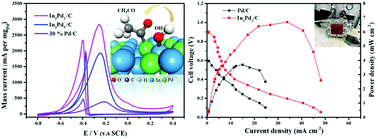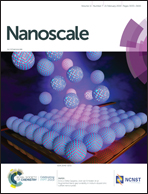Monodisperse ordered indium–palladium nanoparticles: synthesis and role of indium for boosting superior electrocatalytic activity for ethanol oxidation reaction†
Abstract
The slow kinetics of ethanol oxidation reaction (EOR) has limited its widespread use for fuel cells. Bimetallic catalysts with optimized surface compositions can considerably govern rate-determining steps through selectivity for CH3COOH formation or by facilitating the adsorption of OHadsvia the bifunctional effect of an alloy to increase the EOR's kinetic rates. Here, we reported monodisperse ordered In–Pd nanoparticles as new bimetallic high-performance catalysts for EOR. In–Pd nanoparticles, i.e., In3Pd2 and In3Pd5 were prepared using arrested precipitation in solution, and their composition, structures, phase and crystallinity were confirmed using a variety of analyses including TEM, XPS, EDS and XRD. In–Pd nanoparticles were loaded on carbon black (Vulcan XC-72) as electrocatalysts for EOR in alkaline media. In3Pd2 and In3Pd5 nanoparticles exhibited 5.8 times and 4.0 times higher mass activities than commercial Pd/C, which showed that the presence of indium greatly boosts electrocatalytic reactivity for EOR of Pd catalysts. This performance is the best among those of bimetallic nanoparticles reported to date. Such high performance of In–Pd nanoparticles may be attributed to the following two reasons. First, In–Pd nanoparticles exhibited excellent CO anti-poison ability, as confirmed by CO striping experiments. Second, as revealed by DFT calculations of metals with OHads adsorption, In atoms on In3Pd2 surface exhibited the lowest energy (−1.659 eV) for OHads adsorption as compared to other common oxophilic metals including Sn, SnPt, Ag, Ge, Co, Pb, and Cu. We propose that the presence of indium sites promoted efficient free OH radical adsorption on indium sites and resulted in a faster reaction rate of acetate formation from acetaldehyde (the rate determining step for EOR on Pd sites). Finally, a single direct ethanol fuel cell (DEFC) with Pd/C anode was prepared. Compared to the results for a commercial Pd/C anode, the open circuit voltage (OCV) of In3Pd2/C improved by 0.25 V (from 0.64 to 0.89 V) and the power density improved by ∼80% (from 3.7 to 6.7 mW cm−2), demonstrating its practical uses as Pt or Pd catalyst alternatives for DEFC.



 Please wait while we load your content...
Please wait while we load your content...